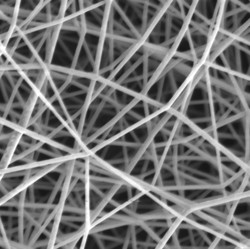Home > Press > Future Materials – Natural Biopolymers Can Be Turned Into Nanofibers With New Device
 |
Abstract:
Hyaluronic acid is a common ingredient in cosmetic creams, eye drops or injections improving the functioning of joints with damaged cartilage. Now, not only are scientists able to produce nanofibers from this substance, but they can also program how long they are to last in the body. What makes "programmable" nanofibers from biopolymers so beneficial? They serve all manner of purposes, from new cartilage to the repair of damaged nerves.
Future Materials – Natural Biopolymers Can Be Turned Into Nanofibers With New Device
Czech Republic | Posted on February 22nd, 2013"The main advantage of the new materials is that they are biocompatible and biodegradable materials which do not cause allergic reactions. What is more, they can be treated so that, once their designated active period ends, they are fully absorbed. Imagine that you have several patients. One lost cartilage in his knee following an accident, the second has injured wrist tendon, and the third is about to undergo an appendectomy. We need a different type of material for each of them. After surgery, in the abdominal cavity you need a separating membrane to prevent unwanted adhesions for just a week. With the knee cartilage, you need resistant material in the form of scaffold, sown with the patient's own cartilage cells, for at least a month. As for the tendons, all fibers must be perfectly arranged in the same direction in order to achieve strength. You must therefore have materials that can be programmed to decay and a device capable of creating nanofibers from biopolymers and structuring them as required. And that is where we have succeeded," says Vladimír Velebný, CEO of Contipro, as he explains the benefits.
How come 4SPIN, the new device for creating nanofibers, has been produced by a company better known for its research and development of raw materials for the pharmaceutical and cosmetics industry? "Our original intention was to create a scaffold using the human body's own material and then to stitch cells onto it. Well-designed scaffolding would provide support for cells and give them signals about how to organize and develop, and how to create a graft to replace the patient's damaged tissue without obstructing the body once healing was complete. The task for the scientists was therefore clear - to spin hyaluronan and structure the fibers. However, there was no equipment on the market that was capable of this, so we developed it ourselves. The result is so good that it would be a shame to keep it to ourselves in our own laboratory. Therefore, we want to offer it to universities and innovative companies," says Velebný.
The synergy of the new apparatus and programmable materials is natural. Contipro is a world leader in the chemistry of hyaluronan (hyaluronic acid), as evidenced by its online catalogue of specialty hyaluronan chemicals for research purposes.
Hyaluronan is a substance that is already present in the human skin, ensuring the smooth movement of our joints, and forming a significant part of the eye. The effects of this substance vary depending on the length of the molecule. For instance, the longest chains are used for skin hydration in cosmetics, whereas the shortest hyaluronan chains are being investigated as a promising means of drug delivery.
####
For more information, please click here
Contacts:
phone +420 465 520 035
fax +420 465 524 098
Tomas Papez
Contipro Group
(420) 606 747 097
address
Contipro Biotech a.s.
Dolní Dobrouč 401
561 02 Dolní Dobrouč
Czech Republic
Copyright © Contipro Group
If you have a comment, please Contact us.Issuers of news releases, not 7th Wave, Inc. or Nanotechnology Now, are solely responsible for the accuracy of the content.
| Related News Press |
News and information
![]() Simulating magnetization in a Heisenberg quantum spin chain April 5th, 2024
Simulating magnetization in a Heisenberg quantum spin chain April 5th, 2024
![]() NRL charters Navy’s quantum inertial navigation path to reduce drift April 5th, 2024
NRL charters Navy’s quantum inertial navigation path to reduce drift April 5th, 2024
![]() Discovery points path to flash-like memory for storing qubits: Rice find could hasten development of nonvolatile quantum memory April 5th, 2024
Discovery points path to flash-like memory for storing qubits: Rice find could hasten development of nonvolatile quantum memory April 5th, 2024
Nanomedicine
![]() New micromaterial releases nanoparticles that selectively destroy cancer cells April 5th, 2024
New micromaterial releases nanoparticles that selectively destroy cancer cells April 5th, 2024
![]() Good as gold - improving infectious disease testing with gold nanoparticles April 5th, 2024
Good as gold - improving infectious disease testing with gold nanoparticles April 5th, 2024
![]() Researchers develop artificial building blocks of life March 8th, 2024
Researchers develop artificial building blocks of life March 8th, 2024
Announcements
![]() NRL charters Navy’s quantum inertial navigation path to reduce drift April 5th, 2024
NRL charters Navy’s quantum inertial navigation path to reduce drift April 5th, 2024
![]() Discovery points path to flash-like memory for storing qubits: Rice find could hasten development of nonvolatile quantum memory April 5th, 2024
Discovery points path to flash-like memory for storing qubits: Rice find could hasten development of nonvolatile quantum memory April 5th, 2024
Tools
![]() Ferroelectrically modulate the Fermi level of graphene oxide to enhance SERS response November 3rd, 2023
Ferroelectrically modulate the Fermi level of graphene oxide to enhance SERS response November 3rd, 2023
![]() The USTC realizes In situ electron paramagnetic resonance spectroscopy using single nanodiamond sensors November 3rd, 2023
The USTC realizes In situ electron paramagnetic resonance spectroscopy using single nanodiamond sensors November 3rd, 2023
|
|
||
|
|
||
| The latest news from around the world, FREE | ||
|
|
||
|
|
||
| Premium Products | ||
|
|
||
|
Only the news you want to read!
Learn More |
||
|
|
||
|
Full-service, expert consulting
Learn More |
||
|
|
||








